Weirdest labor market ever gets a little less weird.
By Wolf Richter for WOLF STREET.
As rumors and reports of layoffs have piled up over the past few months, they all had one thing in common: On the scale of past mass layoffs, there were minuscule, a few dozen people here, a couple of hundred people there, and maybe 2,000 people over there. This was sprinkled with targeted “hiring freezes.”
Back in the day, during the Great Recession, numerous companies announced mass layoffs in the 10,000+ range, such as Hewlett-Packard (24,600), Merrill Lynch (25,000), Circuit City Stores (34,000), Caterpillar (20,000), General Motors (47,000), etc. Those were devastating layoffs, and they were accompanied by innumerable similar and smaller layoffs, and unemployment soared.
But this June, the number of layoffs and discharges were still near historic lows. The number of voluntary quits, where workers went for a better job that another company offered them, were still near record highs. The number of hires remained very high. And job openings, which dropped for the third month in a row, were still in historic red-hot nose-bleed territory.
This is the image of a labor market that remains under pressure – particularly in some industries, such as healthcare and education – while some of the pressure is dissipating in other industries.
This data isn’t based on online job ads or postings or whatever. It’s from today’s Job Openings and Labor Turnover Survey (JOLTS) data that the Census Bureau collected by asking 21,000 employers (businesses and government entities) about their work force in June.
Layoffs and discharges dip, near historic lows.
The small-scale layoffs by some companies – some of which continued hiring in other divisions – and labor shortages still experienced by other companies resulted in a dip in total layoffs and discharges in June (-89,000 from May). The total number of layoffs and discharges, at 1.33 million, was down by 444,000 from June 2019, when the labor market was already hot, and it was near the record low in the data going back to 2000:
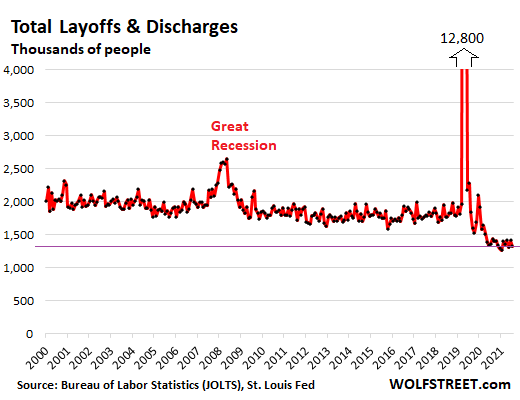
Job openings drop, but remain in the astronomical zone.
Job openings in June fell for the third month in a row, to 10.7 million, down 9.8% from the record in March, seasonally adjusted. But this was still up by 49% from June 2019 and way up there in the astronomical zone.
Let me re-emphasize here that these job openings are not based on online job postings, but on surveys of 21,000 businesses and government entities and their hiring plans.
In other words, the labor market remains tight, employers are having trouble filling positions, but some of those positions have either been filled, or have been pulled by companies trying to figure out where to go from here.
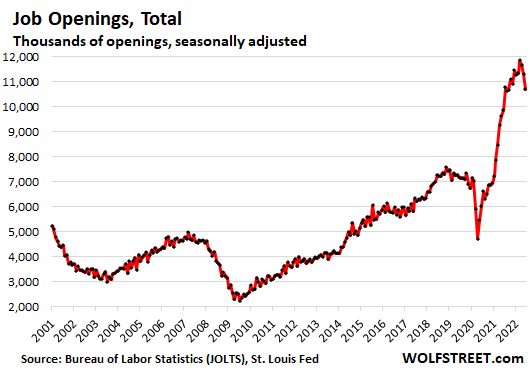
One nearly hilarious illustration of this are the vanishing “metaverse jobs” – nearly hilarious for folks like me who just cannot take the metaverse hype and hoopla seriously. During the metaverse hype-and-hoopla last year and earlier this year, everyone and their dog across all industries were looking to hire metaverse experts. When the metaverse hype-and-hoopla collapsed amid Facebook’s, I mean Meta’s, pull-back, those metaverse job openings just vanished at Facebook, I mean at Meta, and elsewhere.
This tidbit doesn’t come from the JOLTS data, but from an analysis of online job postings by workplace researcher Revelio Labs which found that new monthly job postings across all industries with “metaverse” in the title plunged by 81% between April and June. This was reported a few days ago by Bloomberg.
The Census Bureau in its JOLTS surveys of 21,000 businesses also picked up the vanishing metaverse job openings at the companies it surveyed. But metaverse is not an official industry, it’s virtual industry or whatever, and those metaverse jobs don’t get split out from other jobs.
“Quits” dipped, but still near-record high.
The number of workers who voluntarily quit jobs in June dipped for the third month in a row, to 4.24 million, but was still up by 20% from the already very high levels in June 2019.
This huge number of “quits” largely reflects job hopping by workers who are trying to get a better job, aggressive hiring by companies, and massive churn in the labor force, where workers can leverage the large number of open positions to obtain higher pay and better working conditions.
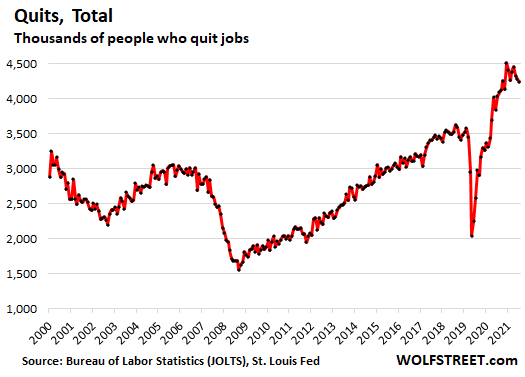
Still aggressive hiring.
Private sector employers hired 5.96 million workers in June, down from May, but up by 9.5% from June 2019. Most of this hiring is of people who already have a job and who quit their old job to get a better job – based on the very large number of quits (4.24 million). Some of these hires fill jobs that were left behind when a worker quit to work somewhere else. This large number of hires is a further sign of the churn in the labor force:
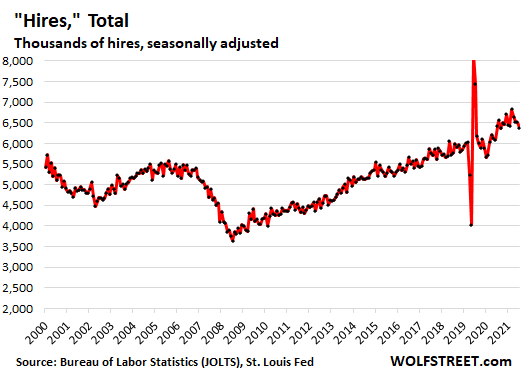
Job openings in the largest private-sector categories.
Healthcare and social assistance: The category with now the largest number of job openings amid frequently reported shortages of doctors, nurses, and other roles. The reasons often cited for these shortages include burnout, pressure, inadequate pay, and tough working conditions.
The number of job openings jumped by 79,000 in June, to 2.05 million, just a tad below the records in February and March. Openings are up by 73% from June 2019,
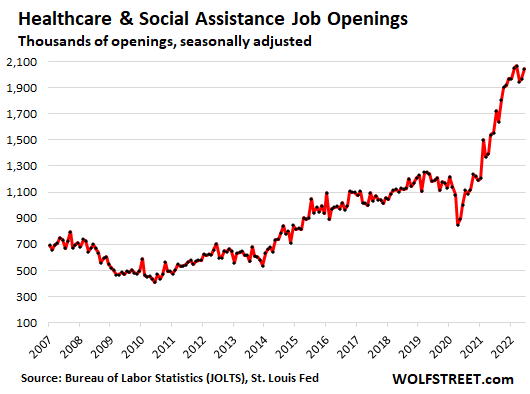
Professional and business services: Job openings were roughly flat in June, compared to May, at 2.0 million openings. This was down by 14% from the peak in March, but was still up 56% from June 2019:
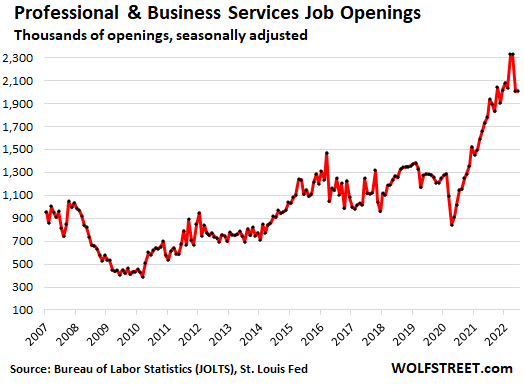
Leisure and hospitality: Job openings have now fallen substantially from the spike last year. Those jobs vanished during the lockdowns and then suddenly re-appeared in huge numbers during the re-opening, and filling them has been tough.
In June, job openings fell by 91,000 to 1.45 million, the lowest since May 2021, but they’re still up by 52% from June 2019:
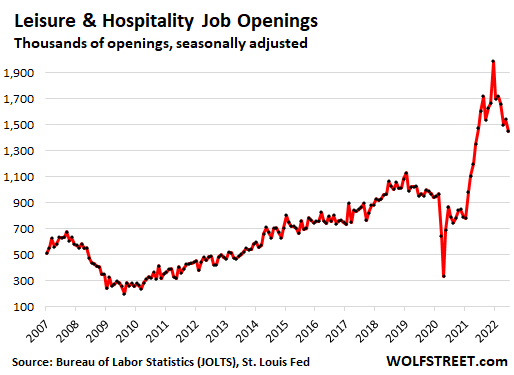
Retail trade: These jobs too vanished during the lockdowns, and then employers tried to re-hire people, which caused job openings to spike, which has now largely been resolved. In June, job openings dropped to 842,000 openings, the lowest since January 2021, and roughly level with June 2019, so back in the pre-pandemic normal range.
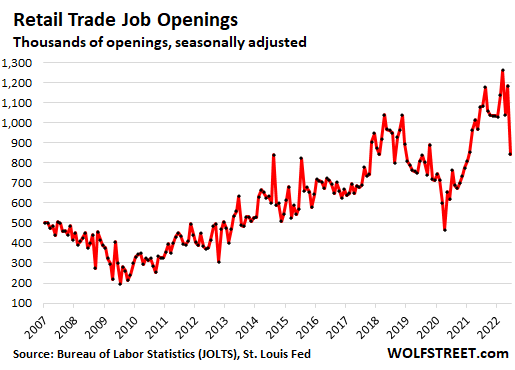
Manufacturing: Job openings dipped by 26,000 in June from May, to 790,000 openings, but remain very high, up by 69% from June 2019:
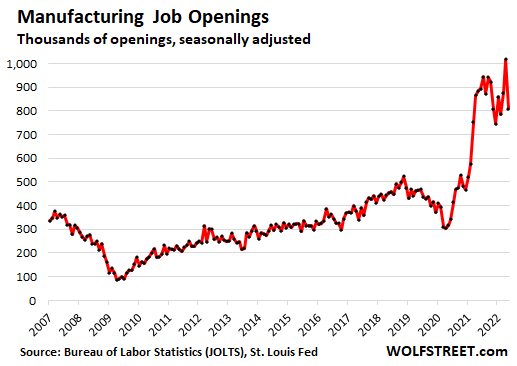
Construction: Job openings dropped by 71,000, the second month in a row of declines from the record in April, to 334,000 openings, but are still up by 7% from June 2019. This may also reflect some of the reports now floating around of projects getting put on hold, or getting cancelled, and not getting started, amid the huge spikes in costs and more uncertainty about demand due to rising interest rates:
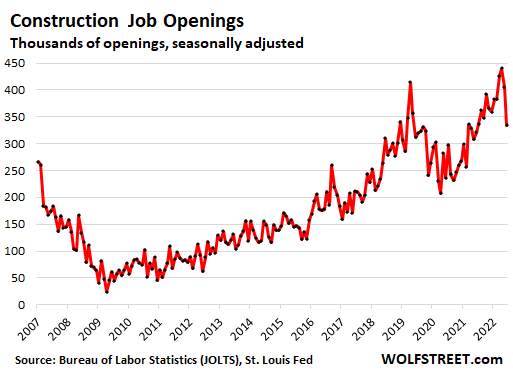
Enjoy reading WOLF STREET and want to support it? You can donate. I appreciate it immensely. Click on the mug to find out how:
![]()


I’m gonna quit! Who wants my job?
Easiest job in the world. I would take it in a heartbeat. Bad decisions all around, no repercussions or terminations, just for showing up to the job every day.
Oh yeah…wait…guess I will keep my job. What was I thinking???
BBBRRRRRRRRRRR!!!!!!
One of our sons recently got promoted to finance manager(city dept)
doesn’t like new added responsibility but chose to stay given fact he’s main income
and DID NOT WANT TO take new job only to get laid off else where
If you believe that the Fed is laser focused on wage inflation (as opposed to housing, health care, and education), this data implies that we have several rate hikes ahead of us.
Systemic conditions are creating a perfect storm for a stubbornly tight labor market. Examples are: an aging labor force, a below-replacement birth rate since the late 1990’s, and a sudden need to re-shore production after recent supply shocks.
Most colleagues and clients I’ve spoken with recently expect that the Fed is bluffing. They are planning their projects as if we’ll get back to low rates soon. Worse, many have open positions they’d like to hire for but can’t and they think they’re just waiting out a temporary post-covid blip in market conditions.
People don’t get to choose to work unless they have the financial means to support themselves.
Demographic claims are a red herring since, as with other supposed reasons, the person otherwise relies on someone else for support or starves.
The economy wasn’t “normal” in 2019 either, but it wasn’t as distorted versus 2020 and later. Like everything else in this economy, it’s substantially increasing debt and an asset mania as the actual cause.
Measured by growth in GDP, the economy was mediocre before the pandemic and didn’t miraculously experience unprecedented organic growth since then either.
Are demographic claims really a red herring when a significant percentage of the work force is at or near retirement age? There may be a large number of people who are willing to work for the right opportunity but will otherwise declare themselves retired and will not starve if they do so.
I am a retired electronics/software engineer. I don’t think my tired 72 year old brain could mount any sort of learning curve required of a new job. I’m retired and I’ll stay retired unless I really get desperate and in that case I’ll probably drive a school bus.
I think the problem is the boomer workers were so much more productive than the younger workers so now more workers are required because the younger workers do less work for more pay. The younger workers also complain a lot more.
Then they are not working because they do not have to work, not because of their age.
Exactly as I stated in my last post.
AF,
I don’t think the situation is as black and white as you seem to think it is. A person may plan to retire at a given age, but for a variety of reasons that date can get pushed forward and they decide to retire even if they don’t believe they are as financially prepared as they would like to be. They will probably take a hit to their retirement lifestyle. They can financially support themselves in that they will not starve, but it’s not the retirement they expected. A young person will not make the decision to retire in those circumstances.
Suffice it to say, I’m not as convinced as you that an aging labor force doesn’t impact the job market.
“I think the problem is the boomer workers were so much more productive than the younger workers so now more workers are required because the younger workers do less work for more pay. The younger workers also complain a lot more.”
LOL!!! Thanks for that laugh!
Funny, just saw some street side ad in my area hiring school bus drivers for $30 / hr. Wondering what the catch is.
I’m sorry, what? Today’s workers are less productive than before? Based on what sources, your gut? Smells like some generational self-aggrandizing BS. Productivity has increased over time while wages haven’t kept up. If older generations “worked harder,” it’s because their labor input wasn’t as supported by current technology as it is now.
So do people today have it easier and whine more? Maybe. But that first bit… that was the future that was being worked towards, wasn’t it? And the second, well, when you live through several economic disasters caused the generation that benefitted the most from that post-WWII boom, maybe the real story is that boomers don’t want to see the finger pointed rightfully at them.
But that’s my own BS talking, I’d say it has more to do with class warfare and corporations winning that war at the expense of everyone else, using wedges like Boomers / Millenials to keep scrutiny off them.
Yup.
AF,
Thanks for pointing out (indirectly) the common sense proposition that a pandemic didn’t magically improve a US economy that had been rickety for 20 years.
Not sure fed is more focused on wage inflation versus other types of inflation. If they were, they might have gone slower since wage inflation hasn’t been as high as the overall numbers. Some in the market are hoping that the jobs report shows mediocre wage inflation, like normal, which means better chance of fed slowing down.
The Fed is way behind the curve, as Wolf has stated. The Fed can’t slow down until they have a real handle on inflation. They aren’t even close yet.
In Canada the cost of living is so high no one can afford to work anymore. There’s huge upward pressure on wages and less workers. Even if the minimum wage was hiked from 15 to 20 dollars an hour in Ontario, Canada they still couldn’t find workers.
Is this like the saying that mostly gets appropriated to Yogi Berra: “Nobody Goes There Anymore, It’s Too Crowded!”?
If the cost of living is too high, doesn’t everyone have to work?
@MF – tell them to listen to the latest Wolf Street Report.
@ Pete K: Note how most of the commenters focused on how they feel about whether age affects a person’s ability to work, rather than broad trends showing what age groups participate most in the nation’s workforce.
Note also the lack of response to other tectonic changes underway that will impact demand for labor (re-shoring, fewer people aging *into* the labor force).
To me, this is why we still have a huge mismatch between the demand for labor and the willingness to pay for it. It’s like how the housing market stalls out when demand evaporates. Sellers tend to sit on their hands waiting for a turnaround. Then everyone capitulates at once and prices fall sharply.
There was a sharp spike in wages when lock-downs were lifted. Then employers seemed to take a pause and adopted a wait-and-see attitude, expecting the supply of labor to return to their concept of normal, which is informed by 40 years of excess supply in all but a few career fields.
If my hunch (and I admit that’s all it is) is right, the Fed’s abrupt and hard shift to hawkishness tells me they, too, are expecting a sudden capitulation amongst employers in the next year or two. If that happens, inflation will rage worse than it already has. That’s what it is trying to avoid at all costs.
The most visible effect I see in front of me in manufacturing/engineering is the absence of boomers in the workplace. My employer was packed with boomers from management all the way down to the factory floor 8 years ago, but now there are almost none. A few of them started to retire in the late 20-teens, but the pandemic really dropped the guillotine… Nearly all of them took an early retirement package and left, never to be heard from around here again. They left job openings behind. My experience lines up profoundly with the charts in this article. What’s sad is many of these early retirees are not going to realize that they retired too early until it’s too late. They’ll still have 10 or 20 years left on this rock, and they’ll be running low on cash, but they’ll be too old to re-enter the workforce when reality hits them.
I’m sure there will be some who didn’t plan well enough and were in the “get me outta here” mode. They’ll need to find something sooner than later. But if they had a bit of a nest egg, others will be able to cobble together investments, part-time jobs, online hustles to keep a reasonable standard of living (unless inflation rages thru next year).
At a certain age most people realize that greater stress, with worse health, is a pretty crappy trade-off for fairly small increases in wealth/status.
They stop giving a crap about what their parents or the Joneses think…the parents are dead and Mr. Jones just had a heart attack at work.
This outlook is greatly magnified when the past/future economic rewards are far from advertised…they will make do with much less because the one thing you can’t buy is more time.
Tne nest part of my nest egg is a house in a rural mountain valley with a property tax bill of $450.00 a year. Yes, I said a YEAR.
However, they exited on top of the biggest bubble. Let’s hope they don’t ride it all the way down.
Tech is great. The trip to Taiwan might be the most expensive trip in
the world.
What we got, we will have to make ourselves.
Until we make it, a lot of empty shelves and empty malls.
Savanna and Long Beach go to sleep.
“Until we make it, a lot of empty shelves and empty malls.”
Michael, most of what everybody has, or wants to get, in this country they really don’t need. Tons of junk, toys, electronic gadgets, etc, everywhere.
I agree with u 100%
And how will they feed there people,could create the biggest revolution ever
The Chinese said they will punish US severely by not shooting her plane down.
Good one; must have flown past most readers.
I’ve got some respect for the ol gal now. She landed in Taiwan with some guts I haven’t seen from our politicians in a while. At least someone has some walnuts.
The real question is why now, after not doing so for decades.
Almost everything DC does is for shabby and/or stupid reasons.
I’m betting on the DC patented “stupid clever” move – P sees the wheels coming off her party/economy and will happily provoke a pointless crisis as a distraction.
Again.
This isn’t a left/right thing.
It is a DC vs the other 325 million of us thing.
Haha. I’m a liberal, but gotta admit that’s pretty funny :-)
LOL no. China needs to sell that stuff, and they need America to buy. American isn’t their only buyer but they can’t just cut someone like us off.
I don’t question the overall assessment, but I’m curious about the JOLTS methodology. Are the same 21,000 employers surveyed? If so, does the degree of representation of the national job market become stronger/weaker over time? If/as the mix changes, how much does that weaken longitudinal comparisons? And how accurate are the survey responses? Are they assigned to the rookie in HR? Does a large company over or under report in an attempt to affect Fed policy? Using job postings, as some have noted, has its own flaws, but I worry about surveys, as people are well aware that the results lead to actions and these actions could impact them.
More data that housing is to be a leading indicator in this particular current/upcoming recession.
“Construction: Job openings dropped by 71,000, the second month in a row of declines from the record in April, to 334,000 openings, but are still up by 7% from June 2019.”
The plunge in “fixed investment” (such as buildings), which took down GDP, kind of fits into this category. But it’s not a huge part of GDP. The huge part of GDP are consumers.
Construction and supply companies seeking to enjoy the extra projects coming from the core infrastructure bill’s billions of dollars are having to scale back on taking new work because 1) materials costs have shot up because of inflation (thus invalidating their earlier bids & cost assumptions), 2) supply chain shortages in the actual materials they need to build the projects, and 3) they can’t find enough people to take their jobs, despite offering benefits and great pay ($20-50/hr to start).
It’s a perfect storm hitting the construction sector right now.
Robin Hood is cutting roughly 1 in 4 jobs.
Ca. 800 people. Small fry, by a failing hype-and-hoopla company, as I said in the article.
It was Oracle on Monday but the numbers weren’t announced as far as I can tell (rumored to be in the thousands though) and RH today. I agree that this is a completely different scale from the Great Recession but time will tell if this is the beginning of the snowball rolling down the hill or just a bunch of housekeeping.
The thing is that a local economy like SF can feel it when 10,000 people lose their jobs locally, and 5,000 of them leave the city. And these job losses are concentrated in startup and tech havens. The rest of the country isn’t affected. So on a nationwide scale, with 158 million working people, the current job losses in tech and startup really don’t measure up, though they can hurt locally.
1) Walmart was jolted, Never gap down like that. It might be badly injured.
2) Amazon is amputated. It gap down and up, a whole section fell apart in the middle of the flight, after two years in distribution.
3) Tech is great, but AAPL, WMT & AMZN might pay price if China turn their back on us.
4) Infrastructure is back, but CAT is breaking today.
With all these jobs, business must be booming, so how can GDP be falling? I guess net income is getting hit by inflated expenses, salaries, and cost of borrowing. Maybe companies are hoping to last through the downturn with acceptable losses and try to stay in business, possibly with maket share taken from those that dont make it through the downturn.
“how can GDP be falling?”
READ THIS:
https://wolfstreet.com/2022/07/28/gdp-sunk-by-plunge-in-private-investment-drop-in-government-spending-consumer-spending-rose-despite-raging-inflation/
Robin Hood just announced a 25% layoff.
800 or so people. Small fry. Like I said in the article.
Small canary, big coalmine.
– your friendly neighborhood Nigerian Prince
The dormers keep quoting these layoffs at these bull$&it companies, like RH. Their product was pretty much crap to begin with and like many other Jonny come lately “financially” related companies, they are likely facing some serious legal headwinds. These jobs at these no profit ever are the first to go when the free money goes away, as Wolf has pointed out dozens of times before.
I think the data is BS, instead of advertising 1 job 40 hours weekly they advertise 4 jobs 10 hours weekly, that way they don’t have to offer extras like holiday, sick pay, pension contributions, also when people are sick plenty want & need more hours. The whole system is corrupt & nearly all data fake.
Whatever data is released I know it’s BS, that’s why it’s contrary to reality, a collapse is taking place & gathering momentum.
Jack X,
RTGDFA
Sheesh!!! Sure enough, each time I write about this, there’s some clueless dude who refuses to read the article but disputes the data thinking that the data is from job ads. Hahahahaha
You’re spouting BS because you didn’t read the article. Here is where the data came from, quoted from the article that you refused to read:
I said it twice in the article. But since you didn’t read it…
Adios
Refute all you want Wolf, people like him won’t believe that dataset either. They believe Facebook memes and whatever dark corner article Drudge has posted that day. Reality doesn’t matter. Anecdotes and what supports their political agendas do.
Does anyone read Drudge anymore. Not heard it mentioned for a few years now.
Wolf,
Great…but simply citing the source isn’t doing the same thing as taking a close look at that source’s methodology.
For instance, that point about 1 40 hr job or 4 10 hr jobs certainly might pertain to the “openings” super spike.
Do you really know how JOLTs handles things like this?
Ditto hirings relative to openings, which I piss you off about every month.
The discrepancy may come from a methodological artifact that only a very close read would reveal.
People keep asking these sort of things because, 1) some macro stats don’t line up terribly well and 2) their personal experience doesn’t line up – which is anecdotal…but the plural of anecdotal is empirical…
Cas127,
I linked the source in the text. All you have to do is look at it. It’s not that hard. The linked page is list of links that includes all the data and explanations of the methodology. If you really want to know, look it up, don’t be so lazy.
The survey goes to EMPLOYERS. Not workers. Think!!! You’re making up nonsense in your questions. So you get a nonsense question. Same nonsense questions every time. You don’t even read the article because you don’t really want to know. You just want to ask nonsense questions. Every time the same thing = trolling.
The financial market’s most knowledgeable inflation traders are expecting a string of roughly 8.8% annual headline U.S. consumer-price readings over the next THREE months, starting with the Aug. 10 release of July’s data.
Fed is already trapped by doing ‘baby’ steps in raising the rate and snail pace in their QT program. 3 FOMC members today contradicted Mr. Powell’s statement, Fed is close to ‘neutral’ rate(!?) Mkts reacted by tanking south.
Many predict, even if the Fed does it’s ‘best’ the inflation will be around 7% this Dec and at best 6% next Dec. Core inflation will remain above 4%.
Their goal of attaining 2% is a delusion.
The fight between the power of perception vs reality will become uglier. Another mega credit event like Lehman, will end this surreal bull.
Source? Who are these “most knowledgeable inflation traders”? And why is everyone else ignoring them?
Since June 16, 2022 the 10 year has been dropping to a low yesterday of 2,5-2,6 and rose slightly today,
Stock and bond markets are ignoring the labor data in the hope that the feds will see something in the economic data to slow things down by spring 2023, The fed is saying the opposite except they are not directing forecasting the sept number which leaves the fed more options based on the data.
Wise move by the fed so they can make moves that are data based and with a month off in August actually see what effect the moves they have made are having on inflation.
So far from the data I see on the Fed balance sheet the bond purchases have flattened and not increased. Maybe the number is dropping as well but hard for me to see 90 billion on a 8 trillion plus balance sheet.
“and rose slightly today,”
hahahahaha, the 10-year yield spiked by 18 basis points today, from 2.57% yesterday at the close to 2.75 now, the biggest one-day spike since June 13
The 10 year US Treasury yield is still far below the 5.25% where it should be and about 50 basis points below where it was one month ago and as a result mortgage interest rates have plunged the most they have in a long time over the past month. Given the massive risk of default with US Treasuries their yield should be around 50%.
The default risk is not remotely ‘massive’. There are many levers America can pull for massive growth, such as immigration reform.
I would say the risk of US Treasuries defaulting is about zero. Yes interest rates are rising, but that will only affect new debts or rolled over debts.
The risk of the US Dollar losing as much as 33% in value in a day sometime in the future though is definitely quite substantial. The BRICS team have been working on a new currency after all and they have the resources to back it.
Abnormalities sprung from abnormalities sprung from abnormal monetary policies.
What else is abnormal?
Well the Fed promotes inflation though mandated to stable prices.
The Fed has inflation at record disparity to the rates they set.
The Fed has gobbled up MBSs creating a raging and broken real estate market.
The Fed skews all they touch, and employment is no exception
No one wants a job working on the “Metaverse” if hard times are coming.
People want something solid-sounding.
I’ve been pinged by a couple of defense companies the last several weeks. If only Putin were an evil genius instead of just evil! He could have invested in the defense industry before scaring the bejesus out of Europe by attacking Ukraine with masses of tanks and artillery.
Back around 1999 when I needed to post a help wanted in the paper it was $2-300 dollars. The internet was new and not so many were on it yet. We were stuck paying it. Now it is very cheap or free. There would be a lot less postings cited in the surveys if companies had to pay like that for job postings.
And when a survey is done, I bet ya that the HR gal just looks at the number of postings and sends that off to the surveyors. It’s a given that a lot of these postings, as cheap as they are, are simply companies fishing for someone they like better, in an anticipation of an opening or someone who will work for less.
Kinda like when your monkey branching X was trolling for a new dude online while you were still there on the couch next beside her.
Apropos of this discussion, was watching a news program a day or so ago (I think it was France 24) which had a review of labor conditions in the US and a long interview (by TV standards) with a business owner in Memphis. He owned a limo company and a coffee shop and was complaining about not being able to hire anyone in either business and how he was down to a single employee in the coffee shop (and that he wasn’t happy because he was having to work in the coffee shop instead of just supervising). He interviewed a prospective employee and said he’d pay over the minimum wage for Memphis ($7.25/hr) up to $8.25/hr. He quickly mentioned that the prospective employee could work the AM shift and “you’ll make $20/hr with tips”. I couldn’t see the prices on the menu board clearly, but it looked like coffee drinks were $4.50 and up depending on size, so not a low-budget place.
So, what is the takeaway from this anecdote? First, prospective employees are available. At the coffee shop, it sounds like the employer KNOWS market clearing wage is $20+ an hour. The employer wants to pay $8.25 and expects that the employee takes the risk that customers will willingly pay a tip to bring the wage up to a fair market level. If he can only break even by paying 40% of the market clearing price for workers, he will never be able to hire anyone. A business model that requires inputs priced at 40% of the market rate isn’t ever going to be viable.
All of the complaints that “I can’t find any employees; nobody wants to work anymore” needs to be appended with the clause “at the rate of pay I’m willing to offer”.
“All of the complaints that “I can’t find any employees; nobody wants to work anymore” needs to be appended with the clause “at the rate of pay I’m willing to offer”.”
You’re not the first one to proffer this observation…. but let me ask you: What is the fair market value of a low skill / minimally educated employee? Many are in here screeching about inflation, yet your “solutions” do nothing more than fuel the inflationary cycle.
Supply v Demand
How does it work??
El Katz,
The FMV is whatever that person is willing to accept to exchange their time for money. In my anecdote, the purchaser of the labor is willing to offer $8.25 but at the same time says that (with tips) the prospective employee will make $20/hr. In other words, the employer understands that $8.25/hr isn’t enough and that the hourly wage to hire the employee is $20/hr. Maybe the employer will hunt around long enough and find someone to take a wage at 40% of the going rate.
To continue, I didn’t offer any solutions, just observations. And the critical observation is this: if a business needs to purchase its inputs at a substantial discount to a market price, it’s not a viable business. If coffee was $20/lb and the shop owner can only pay $8.25/lb, the owner isn’t getting any coffee. The owner’s options are: 1) pay the price for coffee and accept a lower profit margin (potentially negative) or raise prices to offset the higher cost of coffee; or 2) discontinue the business.
What the owner wants is a below market price for a product input. The fact that the component in question is a person’s labor is irrelevant. It could be any input into the production process: coffee, rent, electricity, cups, water, etc.
The type of labor (you define as “low skill / minimally educated”) is of no pertinence: whether a barista or investment banker, if you want to pay half the going rate, don’t expect to find a competent person to accept (or if they do accept for some reason, don’t expect them to stay).
And as far as “fueling the inflation cycle”, if companies (generally) raise prices and those increased profits is seen as positive, why is labor raising prices and increasing “profits” seen as a negative? I haven’t heard anyone asking a business to not raise prices to fight inflation, only labor.
You should open a coffee shop.
FastEddie nailed it. Individual workers are generally terrible negotiators. If you go to the power company and tell them you’re only willing to pay 50% of the going rate for electricity, good luck to you.
In any case, in this example, and pretty much any discussion of low-skill labor, the value of an employee isn’t in what they know, it’s in the fact that they’ll show up on time, sober, and ready to work their full shift. Anybody with any experience running a business knows this, but they want their economic fundamentalism fantasies to take precedence over reality.
Halibut, why would anyone open a coffee shop? It’s a business with close to zero barriers to entry, little differentiation, and tons of established competition (including Mr. Coffee). Opening a coffee shop in almost any locale sounds like a risky idea. Here’s a question: what’s the fair market value of a coffee shop?
El Katz
What’s the LIVING WAGE for this job? How much this business/Corporation makes profit on his/her labor. Do they consider inflation effect on the wage.
Or just suck it, if you want this job.
You wonder why the Great Resignation came from? Labor exploitation by Capital holders is an open secret. Globalization made it worse. De-globalization, labor got some what meager voice. That is not tolerated by the Rentier masters!
Can we just stop with the tipping culture and get back to paying people a decent wage.
So much nicer to go places (countries) where tipping is not a thing.
We all have our own servants now (Uber driver, DoorDash delivery, amazon prime). I’d prefer if we all did a bit more for ourselves.
(Disclaimer: I never use Amazon, rarely eat at a restaurant, never get takeout/delivery, and wash my own car – I’m trying … and life is better for it.)
+1. I hate tipping culture. Look, do you really think those who work in such jobs receive an accurate feedback loop from the tips they receive? No. I know may of us in the US tip the same no matter the service….don’t want to offend anyone!
Just pay people what they need to be paid. And to ensure managers know who is great and who sucks, give some avenue for feedback. No, not Yelp. Like maybe a kiosk at the exit of the cafe or whatever.
To those who say “but but but service will still be terrible.” Hmm, yeah, um, I have had no concerns with service anywhere in Europe, where tipping is not the custom. Although… the ignorant idiot Americans have tipped long enough now to make locals think tipping BY ENGLISH SPEAKERS is normal, and therefore foreign culture overrides local customs, and “we” are held to a difference expectation than locals. Solution…speak their language!
In the US, I am absolutely sick of being guilted into tipping too much by the iPads on the register counters that default to $1 minimum for a $3 coffee, or start at 20% for picking up donuts.
Raising prices to pay a “decent wage” will keep people from coming in the door. Letting people tip the employees directly is better for the business and the customers. People want to feel like their money is going to the person in front of them, in America anyways.
The real problem is that small business is a constantly changing environment where business open and close in short order. Either you strike gold or go broke. I don’t see a lot of in between for small foot traffic reliant businesses.
Imo the relevant questions are:
What is/are good employee/s worth to this particular business?
What wage can the business support?
I would say it’s gonna be a lot more than $8.25 an hour.
And he should forget about the tips.
Fair Market Value is whatever the market is willing to pay. If we’re going to manually assign FMV to people’s jobs, let’s start with American CEOs who earn many multiples of CEOs in other countries who manage equally complex and large companies, with no improvement in operational efficiency that I can see.
A more serious answer is that yes, due to structural issues within a market, there can be pricing distortions that obscure the “true” fair market value. But my beef with that is no one complains about those structural issues when it’s Wall St CEOs making billions even as their companies require massive federal bailouts to not go bankrupt, but every “capitalist” out there gets their panties in a bunch when, due to temporary structural issues, some low skilled worker manages to squeeze a couple extra nickels from their employer.
Best part is he can continue to work there ,see if he can live making 8.25$ a hour what a joke
That was a huge drop in retail trade job openings – 29% in one month. And a pretty good drop in construction – 17.5%. And, credit card debt just went up 13% year-over-year in the second quarter, the largest jump in 20 years.
Those figures all hint at the recession that is coming. Likewise, while Wolf correctly notes that the RH layoffs are small, it and many like it are akin to the falling pebbles that lead to the rockslide. Jobs will be lost, demand is going down in the 3Q, and after the summer trips and splurges, all but the top 10-20% will begin tightening the belt this fall and heading into Christmas. Heck, if people are already hitting up their credit cards now, while the job market is incredible, imagine what will happen in the next 12 months.
I changed jobs last November… turns out the new job, while it pays 35% more, isn’t panning out because the third party I was contracted to serve cut the cord. I’m on the bench collecting paychecks while they try to plug me in at another third party. My skill set is somewhat rare and rather lucrative in cyber security, and by now I’m wondering how long this can go on before they cut the cord. Strange thing is I have no problems getting interviews- one tomorrow with Amazon. I shared my comp to the Amazon HR sourcer/recruiter and she said casually, “oh we can beat that, no problem.” So this job hopping thing is how people like me are beating inflation.
The owner of my DSP had to run a route today…
Amazon offers overtime and incentives during prime week.
So predictable, prime week ended, everyone took the money and ran and now my DSP is short on drivers.
State taxes in Utah are so high, workers will barely see any real increase in their take home pay, no matter how many extra days they work. Workers, will quickly burn out running extra days in what is now, routinely 100+ degree weather.
So many of the reported job openings are meaningless.
So the system is broken, deal with it…
Companies like Amazon, Walmart, Target etc, that rely on domestic workers, need to stop focusing on corporate tax cuts and should instead focus their lobbing efforts on reducing taxes on the labor force that they all rely on.
Public servant means you have dedicated yourself to serve the public. It does not mean you are entitled to make 2 -3 times what you can make in the private sector. It does not entitle you to every benefit currently available and it certainly does not entitle you to a retirement plan equivalent to a now rarely found successful entrepreneur.
Gut the PIG!
Some public servants might make more, but I’d suspect most make less in the public sector. Many leave government jobs due to the slow nature of progress and become private sector consultants to make more money. Also, there is lot of competition and qualifications necessary for those high paying gvt jobs. Governments and businesses used to both have good benefits, businesses just went after unions more effectively than government, helping to create the no-benefits gig economy we have today.
You’re not even in the right month with your story. This data was for JUNE.
Why is this weird? Fewer are willing to work thanks to inflation fanning hand outs, devotion to their “apps”. Those who ARE willing to work, are finding their “labor” in high demand. “Labor” defined as all skill levels offered as long as they are hard working and show up consistently.
Seems it would be a natural conclusion that those willing to work are adjusting, or “job hopping” if you prefer, to improve their lot in what has become a “labor sellers market”. Let the slackards sit on their arses and play video games, while the rest continue to advance in life
Maybe I just think too simplistically.